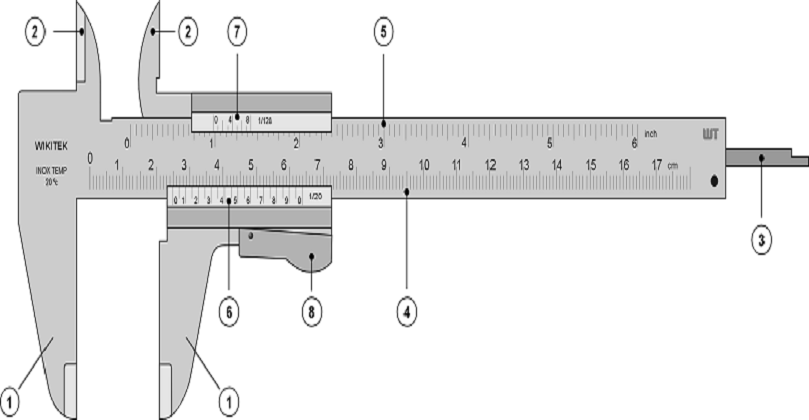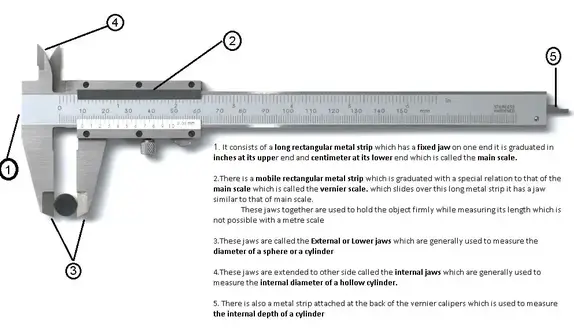Table of Contents
How to find Vernier caliper least count formula? I am very interested to talk to you about this article. The reason is that this article contains very interesting information. Let’s go to this article. Vernier callipers are one of the precision tools used to measure things like distance, external and internal diameters, depths, and heights of any component. The application determines the size of the Vernier Calipers. Vernier callipers come in a variety of sizes depending on the workpiece or task that needs to be inspected and the machine tool being used to complete the task.

Parts of Vernier Caliper
Since Vernier callipers are highly sought after in locations where extremely precise measurements are needed. Therefore, it is important to understand the components of the Vernier calliper, which are listed below. Therefore, the following are the key components of the Vernier calliper
- Main Scale
- Vernier scale
- Thumbscrew
- Lock screw
- Depth Rod
- Fixed jaw, and
- Sliding jaw
- Description
How To Read a Vernier Caliper
- Make sure to determine or calculate the lowest count.
- Close the Vernier caliper completely to analyse if there is any zero error
- If necessary, use the formula for the zero error.
- Hold the test object between the Vernier caliper’s jaws.
- Gently tighten the jaws around the item.
- The primary scale will be to the left of or parallel to the zero on the Vernier scale.
- Calculate the primary scale reading.
- To determine the Vernier scale reading, use X = (n x LC).
X = Fraction of main scale reading
n = Vernier division where it coincides with main scale
LC = Least count
Vernier Caliper Part Description

The Principle of Vernier Caliper
A vernier calliper can measure things up to 1mm, whereas a scale cannot measure objects smaller than that. Vernier callipers, which have two scales—the main scale and the vernier scale—are used to measure extremely small lengths, such 0.1 mm.

Vernier Caliper Least Count
The least count of the Vernier is defined as the difference between the value of one main scale division and the value of one Vernier scale division.

Vernier Caliper Zero Error
- No zero error
- Positive zero error
- Negative zero error
No Zero Error

Positive Zero Error

Negative Zero Error

Types of Vernier Caliper
- Flat edge vernier caliper
- Knife edge vernier caliper
- Vernier gear tooth caliper
- Vernier depth gauge
- Flat and knife edge vernier caliper
- Vernier height gauge
- Vernier dail caliper
Cautions about use of V caliper
- Jaws of V C should be softly closed.
- Applying no adjustment is necessary.
- The cylinder must be in contact with both jaws.
Uses of vernier caliper
- It is employed both internally and externally to determine diameter.
- It is used by plumbers and manufacturers of steel, aluminium, and windows.
Different Parts of Vernier Caliper
- The Primary Scale
- Vernier Scale
- Outer Measuring Jaws
- Inner Measuring Jaws
- The Retainer
- Depth Measuring Prong
How to check that a caliper gauge measures correctly
You can perform two fast tests to see how your gauge is doing. First, there shouldn’t be any light leaking in between the fixed and mobile apertures while it is closed. Second, you can use reference gauges or callipers to double-check the measurement. Since these components were manufactured with extreme precision, you can determine whether or not the gauge is measuring accurately. You can also use a micrometre or another gauge to compare the measurement.
Vernier Caliper (Read Easily) – Parts & Function, Zero Error, Least Count Calculation Explained.
How to Find the Vernier Caliper Least Count Formula?
The Vernier caliper least count formula can be determined by following these simple steps:
- Locate the main scale and Vernier scale on the Vernier caliper. The main scale is the fixed scale on the Vernier caliper and the Vernier scale is the moving scale.
- Measure the length of one main scale division on the main scale. This is known as the main scale least count.
- Measure the length of one Vernier scale division on the Vernier scale. This is known as the Vernier scale least count.
- Divide the main scale least count by the number of Vernier scale divisions. This will give you the Vernier scale least count.
- Multiply the Vernier scale least count by the number of Vernier scale divisions. This will give you the Vernier caliper least count formula.
Example:
Let’s say the main scale least count is 0.5mm and the Vernier scale has 10 divisions. To find the Vernier scale least count, we divide 0.5mm by 10 (0.5mm/10 = 0.05mm). To find the Vernier caliper least count formula, we multiply 0.05mm by 10 (0.05mm x 10 = 0.5mm). Therefore, the Vernier caliper least count formula for this example is 0.5mm.
Frequently Asked Questions:
What is the Vernier caliper least count formula?
The Vernier caliper least count formula is used to calculate the smallest measurement that can be made with a Vernier caliper. It is the smallest division on the Vernier scale that can be read accurately and is usually expressed in millimeters (mm) or thousandths of an inch.
Why is the Vernier caliper least count formula important?
The Vernier caliper least count formula is important because it determines the precision of the Vernier caliper and is essential for ensuring accurate measurements.
How often should I check the Vernier caliper least count formula?
It is good practice to check the Vernier caliper least count formula before making any measurements to ensure accuracy. It should also be checked periodically to ensure that it is still accurate.
Final Words
The Vernier caliper least count formula is an important aspect of using a Vernier caliper for precise measurements. By understanding how to find the formula, you can ensure that your measurements are accurate and reliable. Remember to check the formula before making any measurements and periodically to ensure its accuracy. With the right approach and the right tools, you can make precise measurements with confidence.


